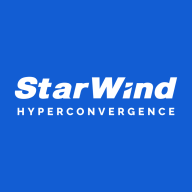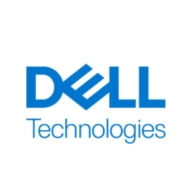

VxRail and StarWind Virtual SAN are leading solutions in the hyper-converged infrastructure and storage virtualization markets, respectively. VxRail seems to have the upper hand in VMware environments due to its seamless integration and management capabilities, while StarWind stands out in cost-effectiveness and ease of integration with existing hardware.
Features: VxRail offers integrated storage and management flexibility, comprehensive updates, and ease of deployment within VMware environments. Its performance and consolidation capabilities are notable. StarWind Virtual SAN excels in cost-effectiveness, efficient redundancy, and seamless integration with existing infrastructures. It is valued for its simplicity in installation and management, reliability, and excellent support.
Room for Improvement: VxRail users seek improved integration, more competitive pricing, and a streamlined update process with faster upgrades and better compatibility with non-Dell hardware. StarWind could improve its documentation, user interface design, and expand support materials while simplifying configuration processes.
Ease of Deployment and Customer Service: VxRail is appreciated for its robust deployment processes and comprehensive customer support, though noted for some complexity in initial setups, ensuring professional assistance through Dell's service model. StarWind is praised for straightforward deployment and clarity during setup, with customer service highlighted for responsiveness and expertise, beneficial for smaller setups.
Pricing and ROI: VxRail is perceived as expensive, with costs tied to VMware licensing, yet justifiable for large enterprises needing scalability. StarWind Virtual SAN offers affordable pricing, especially benefiting SMBs, with cost savings and a perpetual licensing approach supporting various deployment scales.
We don't sell a lot of redundant servers, so it's not a massive ROI, but the ability to rely on their technical support and the software's ease of setup allows us to reduce labor costs and go to market competitively.
The cost benefits, as far as we consider, are much better with a StarWind VSAN solution, and the training requirements with the ease of administration simplify and reduce our administrator and professional services costs.
Regarding cost savings, for my client, it was about 20K USD for his specific use and as for extending capacity, StarWind made that process easy.
Even in the instances where my technical team does not have the ability to manage or troubleshoot or resolve an issue, StarWind's technical team supports and resolves on our behalf very quickly.
They have some awesome guides online that show you exactly how to configure the product, how to do the initial setup, and you can speak with them directly who will be able to connect, verify your setup, run its parameters, and see exactly what's working and what is not, and adjust it, and they really help you with that.
The customer support from StarWind Virtual SAN is great, as the people are knowledgeable and have great knowledge about the product and the functionality we require in the system.
A key area for improvement for VMware would be response time.
Dell has good technical support in Saudi Arabia.
The support is all provided by Dell, and it is quite good.
If we want to expand our storage or add disks, it is easy to add them, configure the RAID, and then deploy it.
I believe that scalability should be further improved, especially considering the possibility that environments may grow exponentially.
When you move from a two-node cluster to a three-node cluster, you have to completely redo the way that they are connected to each other with iSCSI.
There are limitations, such as the inability to upgrade from a single to dual CPU in certain configurations.
Scalability is easy with VxRail.
Scalability is good with VxRail.
In my experience, StarWind Virtual SAN is very stable, and I have never had a single instability issue.
It has been working for five years and the customer is still happy with it.
I ran it on a two-node Hyper-V cluster setup, and I didn't experience any unexpected crashes or major issues.
It is a very stable and mature product, with centralized management and upgrades being perfect for us.
The product is very stable, and I rate its stability as nine out of ten.
A more intuitive interface or an improved dashboard for monitoring the cluster would also be helpful, as it would facilitate performance tracking and help identify potential issues before they affect services.
There have been cases where not understanding exactly what's failing on the Virtual SAN has been an issue.
Limited feedback in the management GUI is the main area where I would like to see StarWind Virtual SAN get better.
It requires a very clean environment to proceed without issues.
VxRail could be enhanced through additional integration with NVMe technology.
The major issue with VxRail is the razoring process, which can only be performed by Dell.
The costs are acceptable and very competitive compared to other hardware-only HCI solutions.
I talked to the sales team, they gave me a quote with a perpetual license with the support and everything went through smoothly.
This is a great product and good support even you are using free version!
Previously, the cost was higher, however, recent changes in VMware pricing have reduced it.
The cost varies for us as a large company because we receive special offers from Dell.
Purchasing VxRail is quite expensive compared to a simple Dell server.
Thanks to its seamless integration with Proxmox, the implementation of high availability servers has drastically reduced downtime, which is crucial for our security-focused company.
StarWind Virtual SAN helps us keep customer satisfaction and provides the solutions we need without having to hire many IT specialists.
StarWind's storage virtualization and failover capabilities have made a difference for my clusters through uptime improvements, with zero downtime specific to server host maintenance or even maintenance of the StarWind software itself.
Customers prefer the single pane of glass management and integration with VMware, which makes it easier for them to proceed with decisions involving VMware products.
The most valuable feature of VxRail is the VxRail Manager, which centralizes resources like storage built with vSAN.
The features of VxRail that we find most useful for our customers include the easy update mechanism and the support for both VMware and hardware.
| Product | Market Share (%) |
|---|---|
| VxRail | 13.8% |
| StarWind Virtual SAN | 2.1% |
| Other | 84.1% |


| Company Size | Count |
|---|---|
| Small Business | 165 |
| Midsize Enterprise | 54 |
| Large Enterprise | 34 |
| Company Size | Count |
|---|---|
| Small Business | 42 |
| Midsize Enterprise | 43 |
| Large Enterprise | 56 |
StarWind Virtual SAN provides high availability and fault tolerance for virtualized environments without the need for dedicated SAN hardware. It allows for real-time replication between servers, shared storage for Hyper-V clusters, and enables vMotion and High Availability features for VMware vSphere. The solution reduces costs and leverages existing hardware while providing a scalable and reliable infrastructure. Valuable features include ease of use, scalability, top-tier support, hardware agnosticism, and the ability to use off-the-shelf standard servers to increase storage space. StarWind VSAN has helped organizations improve performance, data availability, and data security while reducing downtime and providing cost-saving storage options.
VxRail is a hyper-converged infrastructure appliance co-engineered by Dell Technologies and VMware, designed to optimize VMware environments by simplifying compute, storage, virtualization, and management.
Built on VMware vSAN software, VxRail ensures high performance, reliability, and flexibility. It supports a broad array of workloads, from business-critical applications to next-generation use cases. VxRail simplifies infrastructure management with powerful integration and seamless scalability, offering centralized management and user-friendly interfaces. Streamlined updates, robust lifecycle management, and one-click upgrades facilitate a user-centric experience that minimizes deployment complexity and staffing needs. However, its performance with disk deduplication, integration with public clouds, and processor support can be enhanced, along with pricing and licensing improvements.
What features define VxRail?Organizations across sectors such as finance, telecommunications, education, and manufacturing utilize VxRail for its scalability, ease of deployment, and infrastructure management capabilities. It aids in server and application hosting, storage, and virtualization management, often employing VMware integration. The platform is valued for its ability to consolidate IT components, support VDI solutions, and enhance cloud readiness and resource allocation.
We monitor all HCI reviews to prevent fraudulent reviews and keep review quality high. We do not post reviews by company employees or direct competitors. We validate each review for authenticity via cross-reference with LinkedIn, and personal follow-up with the reviewer when necessary.